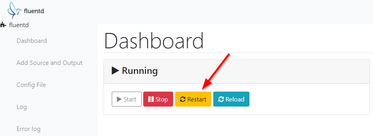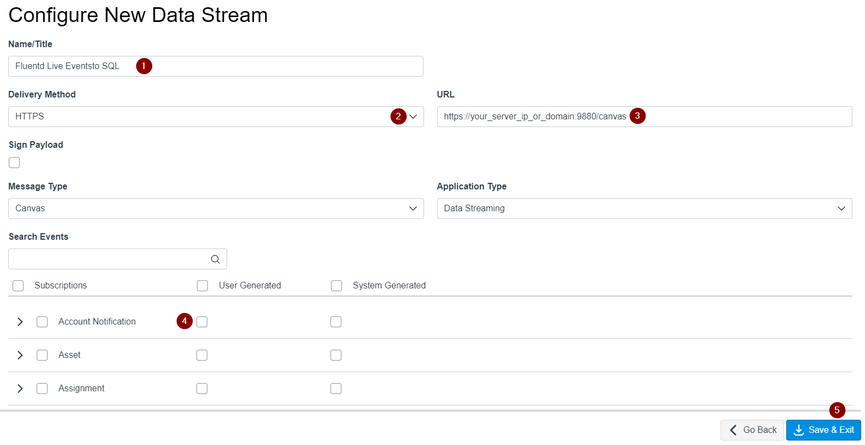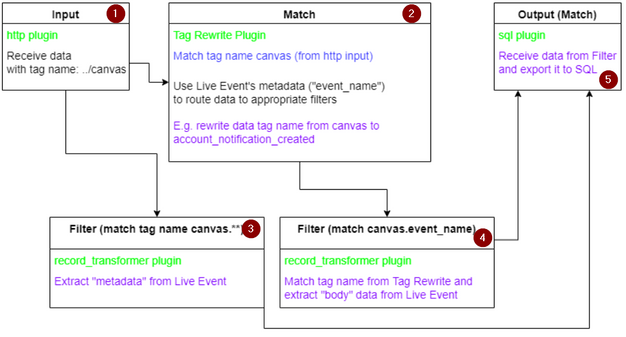Exporting Live Events to SQL database with Fluentd (WIP, Contributions and Testers needed)
- Subscribe to RSS Feed
- Mark as New
- Mark as Read
- Bookmark
- Subscribe
- Printer Friendly Page
- Report Inappropriate Content
Inspiring by @robotcars 's solution to export SQS (Live Events) to SQL (LEDbelly), I'm working on a similar concept.
However, by using Fluentd (open-source), we can eliminate the need for Amazon SQS. Benefits of using Fluentd (What's is Fluentd?) are:
- It's FREE and fast
- Flexible and Extensible (Lots of plug-ins for input/output data - E.g. you can set up an email notification flow based on data received)
- Self-host, thus you have total control over data being sent from Canvas
- It can process a large amount of data with minimal system resources (E.g. 30-40MB of memory to process 13,000 events/second/core)
- Ability to route live data from different Canvas's accounts or sub-accounts to different output
- and maybe more...
Requirements
- Linux server (or Docker instance) that is accessible via the internet
- SSL certificate (free via Let's Encrypt)
Setting Up
A. Set up Database and Fluentd
1. For ease of setup or transition and future updates, I aligned all database schema with LEDbelly's. You can follow the instruction on LEDbelly's GitHub to set up your database (https://github.com/ccsd/ledbelly/wiki/Getting-Started - you will only need to edit the database config file and follow up to step 5)
2. Next, we need to install Fluentd. I use Fluentd-UI to set up Fluentd as it's easier to view logs and config (Alternatively, you can set up Fluentd as a standalone). Enter the following commands to your terminal
If you don't have Ruby Gem on your system, please follow the instructions here to install: https://www.ruby-lang.org/en/documentation/installation/
$ gem install fluentd-ui
$ fluentd-ui setup
$ fluentd-ui start --daemonizeYou can now access Fluentd-UI via your web browser at http://your_server_ip:9292/ .The default account is username="admin" and password="changeme".
3. Once login, click "Install Fluentd". Fluentd and its config file will be located in /your_linux_user/.fluentd-ui/
4. Install plug-ins
#SQL input plugin for Fluentd event collector
$ fluent-gem install fluent-plugin-sql --no-document
$ fluent-gem install pg --no-document # for postgresql
#fluent plugin to rewrite tag filter
fluent-gem install fluent-plugin-rewrite-tag-filter
5. Open fluentd-ui folder and pull config files from my repo
cd ~/.fluentd-ui
git clone https://github.com/jerryngm/fluentd-canvas-live-events-to-sql .
(Please note the period "." at the end of git clone command, this will pull files to the base of fluentd-ui folder)
Then remove the default fluent.conf file
rm fluent.conf
6. Edit fluent.conf.example and save as fluent.conf.
Look for this tag '#your_config_here' and the tag next to it to change the settings accordingly:
- #http_port - endpoint port to receive JSON live data from Canvas (If you have a firewall on your server, you will need to open this port)
- #ssl_cert - enter the path to your domain's SSL (SSL cert can be self-signed or obtain for free from Let's Encrypt - How's To)
- #database_config - config your database here
7. Open Fluentd-UI again and press "Restart"
B. Set Up Canvas Data Service
1. Open "Data Services" from your account/or sub-account Admin page
2. Click "+ Add" button
3. Config as follow:
- Enter stream name
- Select "HTTPS"
- Enter Fluentd endpoint. E.g. https://[your_server_ip]:fluentd_http_port/canvas (/canvas is the tag name that I use in my config)
- Select events (as many as you like) that you want to subscribe
- Press "Save & Exit"
Congratulation 🎉, it's now up and running. You can test it by creating an account announcement or a discussion topic.
Open your database and run the following query to see your live events data 😏
select * from live_discussion_topic_created
or
select * from live_account_notification_created
How Its Works
Fluentd documents are located here https://docs.fluentd.org/
In short, Fluentd consists of 3 main components:
- Input - in our case, we use http as an endpoint to receive JSON data from Canvas Live Events
- Filter - extract or manipulate data
- Output (match) - once data is extracted/manipulated we can then store it (in a database) or trigger an action (e.g. email notification)
Each components process data through various plug-ins
Fluentd Config File
Settings for input/filter/output and its plug-ins are all configurable in a single fluentd.conf file (or multiple .conf file by using '@include con.conf' in the main config file)
Each data received by Fluentd is assigned a tag name (In our case, it's defined by Fluentd's http endpoint which is /canvas)
Data will route through the config file using that tag name
Visualisation of our config flow
- Located in the main config file: https://github.com/jerryngm/fluentd-canvas-live-events-to-sql/blob/main/fluent.conf.example
- Located here: https://github.com/jerryngm/fluentd-canvas-live-events-to-sql/blob/main/config/canvas_tagrewriterule...
- Located here: https://github.com/jerryngm/fluentd-canvas-live-events-to-sql/blob/main/config/filter/metadata/canva...
- Located in "filter" folder: https://github.com/jerryngm/fluentd-canvas-live-events-to-sql/tree/main/config/filter
- Located in "output" folder: https://github.com/jerryngm/fluentd-canvas-live-events-to-sql/tree/main/config/output
To-do list
There are still a lot of works to be done for this project. As you can see I only have the filter and output config files for two (2) event types. Works to be done are as follow:
- ✔️ Filter config files to extract data for each live event (template here.....) (LEDbelly body data for each event)
- ✔️ Output config files to store data to each table (templater here......) (LEDbelly scheme for each table)
- 🆕 Test config files
- 🆕 Batch script to setup Fluentd automatically
- Filter and config files for Calipher message type
- README file and Wiki for our repo
- @robotcars it would be great if we could write a script/or Github action to update Live Event's schema for both of our repo once your's is updated
- A new catchy name??
Please contact me if you want to maintain or contribute to this project. Thank you 😎
You must be a registered user to add a comment. If you've already registered, sign in. Otherwise, register and sign in.





